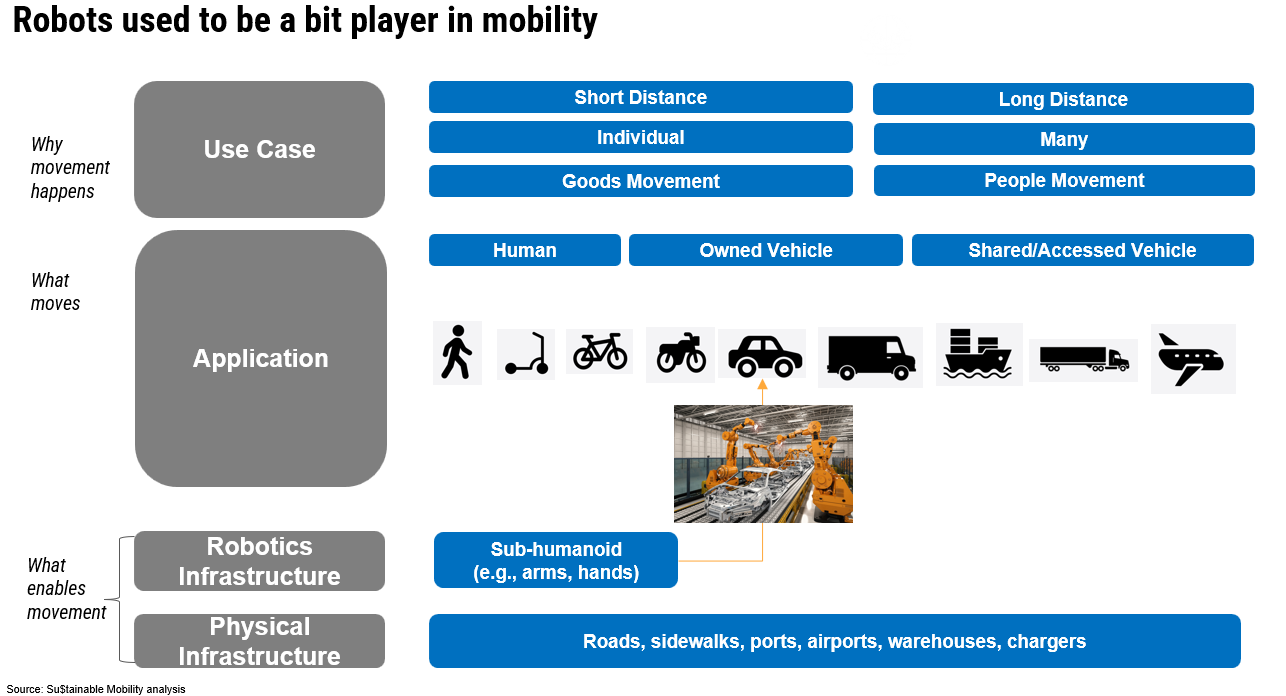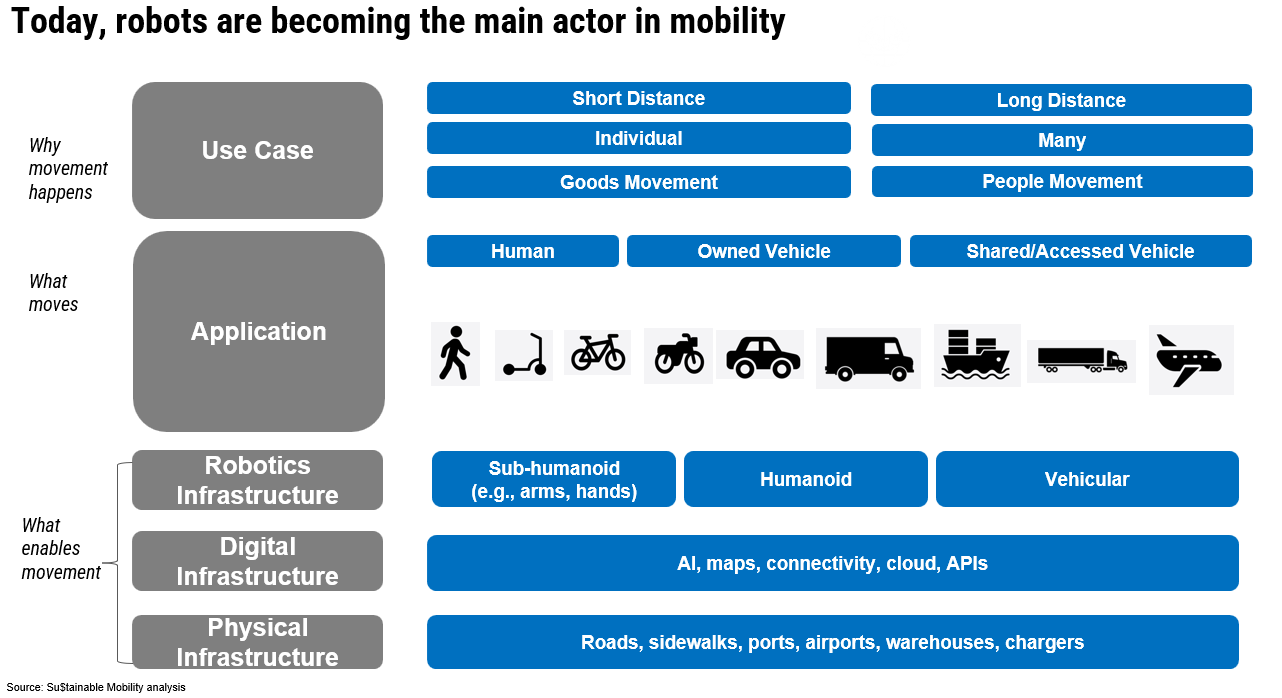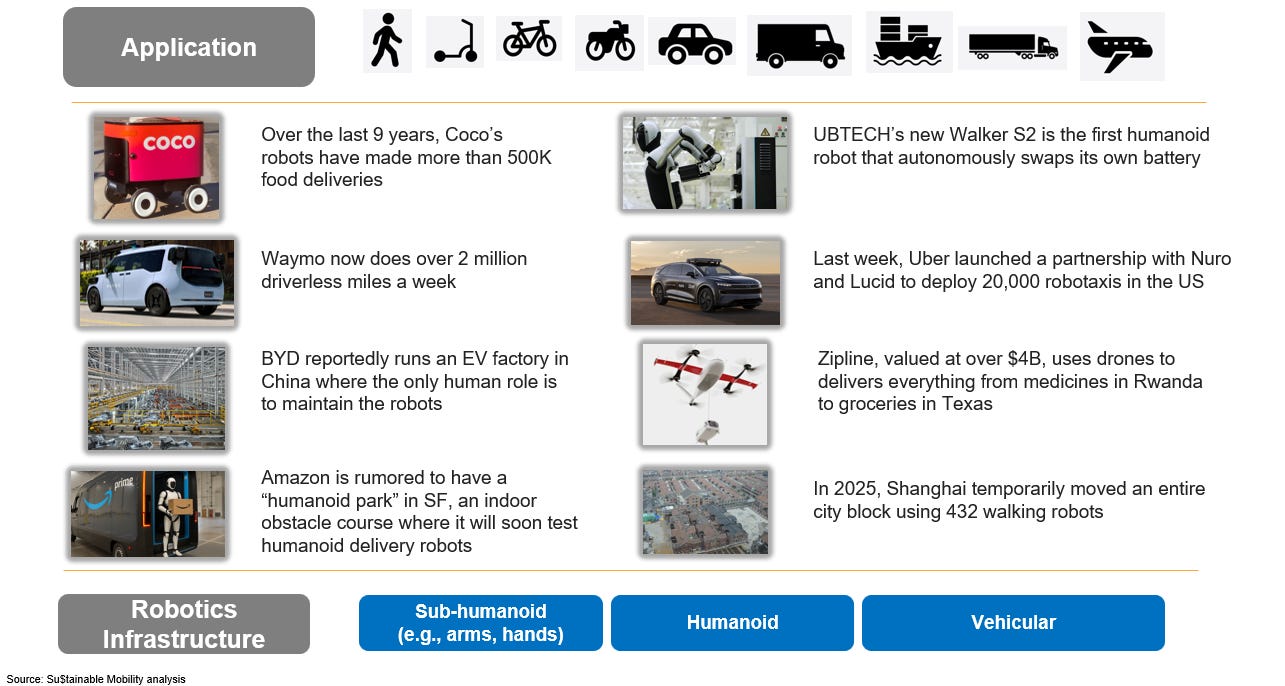This newsletter aims to separate the signal from the noise for investment in all things sustainable transportation: Electrification, mode shift, active and public transit, and mobility aggregation, across both people and goods movement.
This issue’s Deep Dive analyzes how robots, from robotic hands and humanoids to self-driving cars, are becoming both the infrastructure and the application layer of modern mobility.
🌱STARTUP WATCH: Sustainable mobility startups (pre-seed or seed) to keep an eye on
Crabi Robotics (Massachusetts, USA): Autonomous marine robotic system designed to clean marine vessels and removing biofouling
eFoil (Sweden): Electric surfboards and accessories
Infinx Mobility (Cote d’Ivoire): Electric motorcycles & mobile battery network
Little Red Riding Hood (Pennsylvania, USA): Ridehail network for seniors
ScoptVision (Belgium): Software to turn EV chargers into a grid asset
Super Powers Mobility (Pennsylvania, USA): Electrification of off-road vehicles
TetherIA (California, USA): Dexterous robotic hand to enable advanced physical AI
Voltest (North Carolina, USA): EV battery health reports
Western Magnetics Company (California, USA): US-built electric motors for drones and robotics
💰FUNDING: Capital raises from startups previously featured in Startup Watch
Electra (Vol 5) secured a 433M EUR debt facility, bringing their total funding to over 1 billion
Nevoya (Vol 68) raised a $9.3M Seed Round from Lowercarbon, Floating Point, LMNT Ventures, and others
ex9 (Vol 79) raised a 2M EUR Seed Round from Femmes Business Angels, Impulse4Women/SIA, Oscar Club, ARAN Ventures, gener8tor, and others
Estes Energy (Vol 100) raised an $11M Seed Round from Fortescue and BMW iVentures, along with Clocktower Ventures, New System Ventures, and DCVC
Serenity Power (Vol 104) secured $100K for winning the Black Entrepreneurship Investment Prize at Startupfest 2025
Newsletter readers include investors from Maniv, Trucks VC, and Fontinalis…but also urbanists, founders, and policymakers shaping what moves next
📰QUICK HITS: Notable news from the last two weeks
👩🏽⚖️Government, Policies & Cities
😰 In London, actress Joan Collins is up in arms about micromobility. Her diary column in The Spectator didn’t try to hide her xenophobia, with Collins noting, “many of these delivery people are allegedly the same immigrants washing up on our shores.”
🚊 In Atlanta, the CEO of the Metropolitan Atlanta Rapid Transit Authority (MARTA) was forced to resign over a green card delay. A sharp reminder that bureaucracy can derail entire systems.
🏭 California Forever announced the launch of a massive manufacturing-as-a-service offering. Planned cities are always full of surprises, just see the history of EPCOT.
🇨🇳 China continues to tighten its export controls for inputs used in EV batteries. For more context, see the Deep Dive The Next Cold War is Already Here.
👩🏽⚖️ The International Court of Justice ruled that a "clean, healthy and sustainable environment" is a human right. This provides a legal basis for smaller countries to claim reparations against large polluter states.
🔬Markets & Research
🛣️ Progressive think tank Climate and Community Institute has a new white paper on climate transportation policy. It’s a good reminder of how addicted the US is to highway spending.
Join climate investors like ArcTern, Breakthrough Energy, Keyframe Capital, Blue Bear Capital, and Montauk Climate in staying informed…
🏭 Corporates & Later Stage
💧Stellantis scrapped its program to build hydrogen fuel-cell-powered vans. For more on hydrogen, see Hydrogen’s Make or Break Moment.
⚡️Hyundai became the first global automaker after Tesla to adopt the 48-volt standard. Hyundai/Kia might be the legacy carmaker most successfully transitioning into the electric era. Perhaps the fact that the company’s car history only dates to 1967 is an asset in the EV transition versus, say, the long history of Mercedes.
↘️ Tesla reported its second straight quarter of large revenue declines, with all hopes pinned on autonomy and robotics. It’s not ideal that the company might be launching its robotaxi network in SF this weekend without approval and is behind on its robotics goals.
🚉 In the US, rail giant Siemens will supply the nation’s first battery-electric trains, capable of running either on overhead catenary wire or by battery. New York’s MTA will utilize the trains on Metro-North, potentially expanding to communities on non-electrified lines, such as Danbury, CT.
🙋🏽♀️Uber launched "Women Rider Preferences" in LA, SF, and Detroit, letting women drivers opt to pick up women riders. A good reminder of how mobility and personal safety are inextricably linked.
🚐 Lyft is partnering with Bentler for autonomous shuttles. There’s still a lot for Lyft to figure out in autonomy.
🐣 Startups & Early Stage
🚙 Peer-to-peer carsharing startup Turo acquired many of the assets of Kyte. Kyte had raised over $500M in funding to scale the model of delivering rental cars to people’s homes.
🔋 Natron, the sodium-ion battery startup, may be running out of money. Nobody said building a battery value chain in the US would be easy.
🚄 Brightline, the higher-speed private rail startup in the US, is quite far from its revenue and ridership targets. Perhaps that’s why high-speed rail in other countries is generally a public good, not a private enterprise.
🔨 Former engineers from Waymo raised $80M to make construction autonomous. It will be a nice help, but the big unlock for making construction more cost-effective in the US requires policy reform.
🛴 UK-based scooter startup Bo has unveiled an e-scooter that can move at 160km/h (100mph). Luckily, the scooter isn’t really for sale…
📈 Transit optimization startup Via has filed for an IPO. After almost $1B and 13 years of history, early investors are looking to get their returns.
Readers of the newsletter come from 90 countries. Not yet a subscriber?
DEEP DIVE: The Robots are Moving Themselves
Mobility is a vertical domain focused on the movement of people and goods, including what gets moved, where and why. Robotics, on the other hand, is a horizontal capability linked to machines that can sense, process information, and act upon the physical world.
For the last several decades, robotics and mobility hardly intersected. Those days are now firmly over. Much as AI is a fundamentally transforming finance, healthcare, and education, robotics is now becoming a core infrastructure layer of mobility.
And the robots don’t care what’s in their path. Just as AI might decimate traditional software industries, newly developed hardware will allow robots to reshape the application layer of the entire mobility ecosystem, replacing both humans and vehicles in making the world move.
Czech writer Karel Čapek introduced the concept of the robot in the 1920s. Fresh from the horrors of the first World War, Čapek’s play “R.U.R.” warned against the mechanization and dehumanization of our lives.
In the 1940s and 1950s, science fiction writer Isaac Asimov had a much more optimistic assessment of robots and their potential role in society, articulating the Three Laws of Robotics.
Despite both Čapek’s fears and Asimov’s optimism, the impact of robotics on our mobility system (and world in general) was quite limited. One of the most notable applications was in factory automation, starting in the 1960s.
But the concept of a fully automated factory remained elusive. By the 1980s and 1990s, experiments had taught automakers that only a subset of manufacturing tasks could be delegated to robots; humans remained indispensable.
In the last few decades, though, the fundamental infrastructure of both software and hardware has evolved tremendously. As a result, robotics is not just fundamental supporting infrastructure, but also replacing traditional mobility form factors.
While there’s a public debate about the impact of AI on how work gets done, there has been less discussion about the impact of robotics. Every sidewalk robot improves the fleet. Every robotaxi mile sharpens the stack. Humans don’t scale this way.
As with software, the real disruption from robotics comes not from replacing one task, but from rewiring the entire cost structure of movement. When labor becomes software, when vehicles become fleets, and when delivery becomes autonomous, the economics of mobility change.
Whether this ultimately helps or hurts our sustainability goals for transportation is an open question. Either way, the robots are moving themselves and taking the entire mobility stack with them.
Enjoyed this issue? Share it with someone before the robots do…




